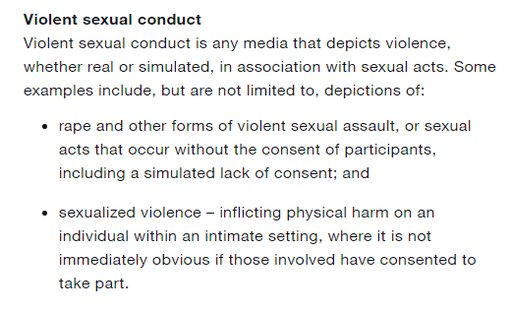2019: The Year Of Twitter #Pornocalypse
Folks, it’s official: Twitter is no longer an adult-friendly or porn-friendly platform. The pornocalypse comes for us all, and in 2019 it came for Twitter. A series of incremental rule shifts mean that Twitter now proposes to ban any predominantly-adult accounts. What’s more, they have formalized shadowbanning as policy without becoming any more open about the process or what triggers it. And finally, rule changes around “graphic violence” and “violent sexual conduct” appear to completely prohibit a great deal of kinky pornography, especially if it involves BDSM, urine, or semen.
Let me not overstate the case: we aren’t hearing — yet — about widespread banning of porn accounts from Twitter. But the rules are in place, in some cases since June. And it’s a fool’s hope to think “Perhaps they won’t enforce against me…” The usual pornocalypse pattern is to change the rules, wait a respectable period, and then start the porn bannings. At which point the rhetorical justification is “Why are you complaining? What you’re doing has been against the rules since forever, we were actually being nice for letting you slide so long…”
Once upon a time, the Twitter status quo was that porn was pretty much OK so long as you marked your account “sensitive” and kept your nose (aka your avatar and header graphics) clean. That changed in a policy dated March 2019, but the new policy didn’t actually appear on Twitter’s website until some time between May 25th and June 7th:
Yup, since June it’s been the case that “your account may be permanently suspended if the majority of your activity on Twitter is sharing sensitive media.” “Sensitive media” is graphic violence, adult content, violent sexual conduct, gratuitous gore, and hateful imagery. Adult content is “any consensually produced and distributed media that is pornographic or intended to cause sexual arousal.” Just in case you were feeling hopeful, erotic art isn’t exempt: “This also applies to cartoons, hentai, or anime involving humans or depictions of animals with human-like features. What’s more, the definition of “graphic violence” mysteriously includes “depictions of bodily fluids”, so no snowballing, ejaculation, facial cumshots, squirting, or watersports. The definition of “violent sexual conduct” is written in a way that prohibits vast swathes of BDSM porn, too:
“Simulated lack of consent” describes most modern bondage porn. And BDSM porn that includes whipping or spanking? That’s “sexualized violence”, because it’s almost never “immediately obvious if those involved have consented to take part.” Of course in commercial porn they have consented, but our proofs are in the context: the interviews at the beginning of the porn shoot, the happy smiles at the end, the researchable reputation of the porn producer, the willingness of the performers to return for additional shoots. Still images and short clips can’t usually encompass enough of this evidence of consent to make it “immediately obvious.”
After the March-dated set of rules that Twitter published in June, there was another update to the Sensitive Media Policy dated November, differing from the June (March-dated) set only by a few words. But there are also changes elsewhere in the Twitter Terms of Service (TOS). As XBIZ reports, Twitter is finally updating its TOS to permit the shadowbanning behavior for which it is already notorious:
In a nutshell: Twitter has explicitly reserved the right to shadowban, under the legalese of “limit distribution or visibility of any Content on the service.”
This is the paragraph from the March 2018 terms of service, which apply until December 31, 2019:
“Our Services evolve constantly. As such, the Services may change from time to time, at our discretion. We may stop (permanently or temporarily) providing the Services or any features within the Services to you or to users generally. We also retain the right to create limits on use and storage at our sole discretion at any time. We may also remove or refuse to distribute any Content on the Services, suspend or terminate users, and reclaim usernames without liability to you.”
And this is the revised passage, effective January 1, 2020 (italics added by XBIZ):
“Our Services evolve constantly. As such, the Services may change from time to time, at our discretion. We may stop (permanently or temporarily) providing the Services or any features within the Services to you or to users generally. We also retain the right to create limits on use and storage at our sole discretion at any time. We may also remove or refuse to distribute any Content on the Services, limit distribution or visibility of any Content on the service, suspend or terminate users, and reclaim usernames without liability to you.”
I tweeted about all this back in June, when Twitter started the #pornocalypse ball rolling, but I didn’t make a blog post then:
#Pornocalypse comes for us all. Twitter too: "Accounts dedicated to posting sensitive media [including all "adult content"] – your account may be permanently suspended if the majority of your activity on Twitter is sharing sensitive media." https://t.co/S0AH2PdIRh
— ErosBlog 🇠Bacchus (@ErosBlogBacchus) July 3, 2019
I did, however, predict new #pornocalypse rules in April, before they started rolling out:
I'll bet somebody a chicken dinner there will be some #pornocalypse bullshit encoded in these Twitter rule changes: "We are updating our rules in the next few weeks so they’re shorter, simpler and easier to understand." https://t.co/pMTqyjiRn0
— ErosBlog 🇠Bacchus (@ErosBlogBacchus) April 16, 2019
There are several recent web articles offering more analysis of the Twitter #pornocalypse, but read them with care. All of them, to one extent or another, seem to conflate the changes in June with the recently-announced TOS changes that haven’t happened yet. That said, they offer more analysis of the implications than I’ve attempted here:
- Sex workers fear a Twitter ‘NSFW ban’ is coming in 2020 (Daily Dot)
- Twitter’s NSFW Purge Looms (Gizmodo)
- Twitter to introduce stricter content NSFW guidelines – worrying adult content creators (The Next Web)
It’s long been my view that Twitter wouldn’t remain friendly to adult content forever. The pornocalypse comes for us all — there’s no social media platform that’s immune. But Twitter, famously, was the last major platform standing. It’s going to be a much bigger blow when they start banning all the image-posting accounts, the erotic-art accounts, and most especially, all the accounts of porn performers and other adult-industry people whose accounts exist for the sole purpose of sharing and promoting their work. I don’t care if people start defensively including 51% political tweets, or puppy tweets, in an effort to avoid the deathly “dedicated to posting sensitive media” label. If sharing of adult imagery is any major fraction of your reason for being on Twitter, you’re at risk of having some faceless support person, probably backed up by some algorithm that scores your account with an internal “sensitive media rating”, decide to terminate your account. Look for porn performers, artists, and, yes, sex bloggers, to start disappearing from the platform.
Don’t think you can argue “but my sensitive media wasn’t the majority of my activity! My account wasn’t ‘dedicated’ to it!” You can’t lawyer-lips the #pornocalypse. Once a platform declares itself adult-hostile, which Twitter now has, the actual enforcement is always arbitrary, capricious, and without much hope of meaningful appeal. Even if there’s “sensitive imagery” in less than 10% of your posts, say, a hostile eye looking at your account is likely to parse the image-sharing (especially if it supports your livelihood) as the thing your account is “dedicated to”, discounting the rest of your activity as ancillary chaff. You want get some anonymous underpaid outsourced support staffer to look at your statistics “proving” that porn is in less than 50% of your posts? First, you’ll never be given a chance to make that argument, and second, even if you somehow manage it, they won’t care. Good luck with that.
In the Daily Dot article I linked above, the report reached a Twitter spokesperson, who tried hard to suggest that nothing was really changing in all this. Then the reporter specifically asked about the banning of accounts “dedicated to” adult material that’s otherwise permitted by the Sensitive Media Policy:
When asked whether Twitter will ban users who primarily share consensual porn or fictional illustrations of consensual nonconsent, Twitter did not clarify.
That refusal to clarify speaks volumes, and what it says is nothing good.
I believe, too, that it’s significant that Twitter no longer denies shadowbanning. We can expect it to see it deployed a lot more readily against adult-focused accounts. There were limits to how far Twitter could go when their official claim was that shadowbanning did not happen. But on all social media platforms these days, sneaky ways to minimize the visibility of adult material are popular. An outright ban can be argued, if only in the court of public opinion. But search invisibility is a penalty that’s extremely difficult to prove, much less complain about — especially when it’s applied by secretive algorithms to content that fully complies with the applicable content policies and terms of service.
I’d like to wrap this up with some helpful suggestions about where to continue the adult conversation once Twitter finishes suppressing it, but I don’t have any. There are a bunch of minor social media platforms that have started up to implement free speech goals, but none that I’ve seen have the kind of adoption and broad social graphs (at least, not yet) that make the major platforms worth bothering with. At least for now, we’re facing life in a world where all social media is a hostile place for adult expression.
I know I’m faintly famous for my Bacchus’s First Rule coinage, which suggests we all retreat and retrench to web spaces that we control. I still urge people to do this; it’s the best way to save something from the pornocalypse. But it’s not even the start of a solution to the problem. We like social media for its connectivity. When all the platforms are united in putting porn firmly beyond the pale of acceptability, it may be possible to preserve our unwelcome adult-community identities by sharing our content from platforms where we can’t be deleted, but that does nothing to connect us again. When all the search and connectivity is controlled by massive porn-hostile corporate platforms, how do we find each other and our audiences?
Similar Sex Blogging:
- #Pornocalypse Comes To Instagram: XBIZ Explains It All
- Pornocalypse FUCK!
- Tumblr #Pornocalypse Endgame: Porn Banned
- Still Banned From Twitter: Rocket Upskirts
- Banned From Twitter: Petticoat Upskirts
- #Pornocalypse Capital: Sex Robot Edition
- Pornocalypse Comes For Your Keyword Searches
- Network Effects Are Why #Pornocalypse Is Bad News
- Twitter #Pornocalypse? "A Bug" – Says Twitter
- #Pornocalypse Comes to Twitter
- Google/Blogger's "Existing Policy Prohibiting Commercial Porn"
- Google Buries The Blowjobs
- Bacchus's First Rule Of The Internet
- The Pornocalypse Comes For Us All
Shorter URL for sharing: http://www.erosblog.com/?p=24365










Does Mastadon offer a meaningful alternative, discoverability aside? What about Discord?
I appreciate your reporting on this.
I don’t know if we can put discoverability aside. That’s rather the entire point of social media, isn’t it?
For that reason, I’m not well placed to answer your question. I haven’t felt I have the time to explore social media platforms with small reach. I hear things, but there’s not much point in me repeating second-hand impressions.
I am one of these people who figures a social media platform is large enough to be useful when I start seeing intriguing links to content there on other competing platforms. That hasn’t happened in my feed with respect to Mastadon, Discord, or any of the other new-ish efforts.
Hmmm, a big plus (or con, if you ask our corporate overlords & their fan-clubs) of a decentralized network like Mastodon/Fediverse or Diaspora is that no authority exist who can enforce content policies for the whole network. Mastodon’s user base has been growing fast, making it a reasonable bet the Fediverse thing will keep growing, as more and more users are forced out of corporate-owned media by content policies.
It used to be that porn drove tech innovation and user-base growth. Or is it perhaps a feature of the current pornocalypse that such a thing can’t happen anymore? (That would be the case if porn’s previous power were only based on its money-making potential, that is, on corporate capital ultimately backing it, as it is that same corporate capital that has now resolved to damn porn, whatever the motive is.)
Real search engines and links work for a lot, but many people still trust Google to give them useful results, and many people are out of the habit of using links to find things and bookmarking the good ones. I saw someone ask for “YouTube but with a better recommendation algorithm” but recommendations by algorithm got us here in the first place!
Many people seem to expect that their website should constantly beep and flash with responses like a twitter/FB/Reddit feed. Coincidentally, social media sites are designed a way which works great for a large corporation, but is harder than a simple HTML + CSS site for an ordinary person to build.
I knew it was coming and agree, it won’t matter how clean you keep your posts.
[…] have plagued adult performers and sex bloggers on Twitter for years, though denied by Twitter until the recent release of their new 2020 terms of service incorporating shadowbanning as normal practice. Yesterday, however, I discovered a new-to-me type of search invisibility on […]
[…] has not been an adult-friendly platform since at least 2019, when it added porn-hostile terms of service (TOS) that are so far mostly unenforced. But now comes word that our old friends at Morality In […]